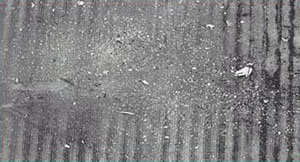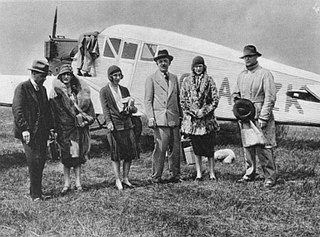Related Research Articles

Biggin Hill is a settlement on the south-eastern outskirts of Greater London, England, within the London Borough of Bromley. Within the boundaries of the historic county of Kent, prior to 1965 it was also in the administrative county of Kent. It is situated beyond London's urban sprawl, 15.2 miles (24.5 km) south-southeast of Charing Cross, with Keston to the north, New Addington to the north-west and Tatsfield, in the neighbouring county of Surrey, to the south. At the 2011 Census, Biggin Hill had a population of 9,951.
The Societé anonyme belge d'Exploitation de la Navigation aérienne, better known by the acronym Sabena or SABENA, was the national airline of Belgium from 1923 to 2001, with its base at Brussels National Airport. After its bankruptcy in 2001, SN Brussels Airlines was formed through a takeover of former subsidiary Delta Air Transport and took over part of Sabena's assets in February 2002, which became Brussels Airlines after a merger with Virgin Express in March 2007. The airline's corporate headquarters were located in the Sabena House on the grounds of Brussels Airport in Zaventem.

London Biggin Hill Airport is an international airport at Biggin Hill in the London Borough of Bromley, located 12 NM south-southeast of Central London. The airport was formerly a Royal Air Force station RAF Biggin Hill, and a small enclave on the airport still retains that designation.
This is a list of aviation-related events from 1935:

On 16 November 1937 a Junkers Ju 52/3m owned by Belgian airline SABENA, operating as a scheduled international passenger flight from Munich, Germany, to London, England, crashed near Ostend, Belgium. The aircraft hit a tall factory chimney while attempting to land at Stene aerodrome near Ostend, Belgium. The accident killed prominent members of the Hesse royal family on the way to London for the wedding of Louis, Prince of Hesse and by Rhine.

American Eagle Flight 4184, officially operating as Simmons Airlines Flight 4184, was a scheduled domestic passenger flight from Indianapolis, Indiana to Chicago, Illinois, United States. On October 31, 1994, the ATR 72 performing this route flew into severe icing conditions, lost control and crashed into a field. All 68 people aboard were killed in the high-speed impact.
Belgian International Air Services was a Belgian airline with its headquarters in Antwerp and Brussels. It was operational between 1959 and 1980 and offered mainly passenger and cargo air charter flights from Brussels Airport to the former Belgian colonies in Central Africa.

Tatsfield is a village and civil parish in the Tandridge District of Surrey, England. It is located 3.3 miles north west of Westerham and 3.9 miles north east of Oxted, and is adjacent to the Surrey border with both Greater London and Kent.

The Savoia-Marchetti S.73 was an Italian three-engine airliner that flew in the 1930s and early 1940s. The aircraft entered service in March 1935 with a production run of 48 aircraft. Four were exported to Belgium for SABENA, while seven others were produced by SABCA. The main customer was the Italian airline Ala Littoria.

Ala Littoria S.A. was the Italian national airline that operated during the fascist regime in the 1930s and 1940s.
Wadi Halfa Airport is an airport serving Wadi Halfa in Sudan. The airport is approximately 14 kilometres (8.7 mi) east of Wadi Halfa.
Lympne Airport, was a military and later civil airfield, at Lympne, Kent, United Kingdom, which operated from 1916 to 1984. During the First World War RFC Lympne was originally an acceptance point for aircraft being delivered to, and returning from, France but was later designated as a First Class Landing Ground, RAF Lympne. It became a civil airfield in 1919 and saw the operation of early air mail services after the 1918 armistice. It was one of the first four airfields in the United Kingdom with customs facilities.

Northwest Orient Airlines Flight 6231 was the fatal crash of a Boeing 727 in the eastern United States on December 1, 1974 in Harriman State Park near Stony Point, New York, just north of the New York City area. The Northwest Airlines 727 had been chartered to pick up the Baltimore Colts professional football team in Buffalo in western New York.

The Meopham Air Disaster occurred on 21 July 1930 when a Junkers F.13ge flying from Le Touquet to Croydon with two crew and four passengers crashed near Meopham, Kent with the loss of all on board. The report of the inquiry into the accident was made public, the first time in the United Kingdom that an accident report was published.

The 1933 Imperial Airways Ruysselede crash occurred on 30 December 1933 when an Imperial Airways Avro Ten collided with one of the radio masts of Belradio at Ruysselede, West Flanders, Belgium and crashed killing all ten people on board. The aircraft was operating an international scheduled passenger flight from Cologne, Germany to London, England via Brussels, Belgium.

The 1929 Luft Hansa Junkers G.24 crash occurred on 6 November 1929 when a Junkers G 24 of Luft Hansa crashed at Godstone, Surrey, United Kingdom while on an international scheduled flight from Croydon, Surrey, United Kingdom to Amsterdam-Schiphol Municipal Airport, Amsterdam, Netherlands. Of the eight people on board, Glen Kidston was the only survivor.
Ramsgate Airport was a civil airfield at Ramsgate, Kent, United Kingdom which opened in July 1935. It was briefly taken over by the Royal Air Force in the Second World War, becoming RAF Ramsgate. The airfield was then closed and obstructed to prevent its use. It reopened in 1953 and served until final closure in 1968. The site has now been redeveloped as an industrial estate.

The 1923 Daimler Airway de Havilland DH.34 crash occurred on 14 September 1923 when a de Havilland DH.34 of Daimler Airway operating a scheduled domestic passenger flight from Croydon to Manchester crashed at Ivinghoe, Buckinghamshire, England, killing all five people on board.

The 1924 Imperial Airways de Havilland DH.34 crash occurred on 24 December 1924 when de Havilland DH.34 G-EBBX of Imperial Airways crashed at Purley, Surrey, United Kingdom killing all eight people on board. The aircraft was operating a scheduled international flight from Croydon, Surrey, to Paris, France. It was the first fatal accident suffered by Imperial Airways and led to the first public inquiry into a civil aviation accident in the United Kingdom. As a result of issues brought up during the inquiry, Croydon Airport was expanded, absorbing most of Beddington Aerodrome.
References
- ↑ "Civil Aircraft Register – Belgium". Golden Years of Aviation. Archived from the original on 24 July 2011. Retrieved 12 February 2011.
- 1 2 3 "Eleven Killed in Air Disaster". The Times. No. 47244. London. 11 December 1935. col E, p. p16.
- 1 2 3 "Tatsfield Air Crash". The Times. No. 47274. London. 17 January 1936. col A, p. p9.
- ↑ "The Tatsfield Crash". Flight (19 December 2011): 637.
- 1 2 "The Tatsfield Air Crash". The Times. No. 47245. London. 12 December 1935. col C, p. p18.
- ↑ "Death of Sir John Carden". Flight (12 December 2011): 626.
- ↑ "Tatsfield Air Crash". The Times. No. 47530. London. 12 November 1936. col D, p. p11.
- ↑ "The Tatsfield Accident". Flight (19 November 1936): 566.